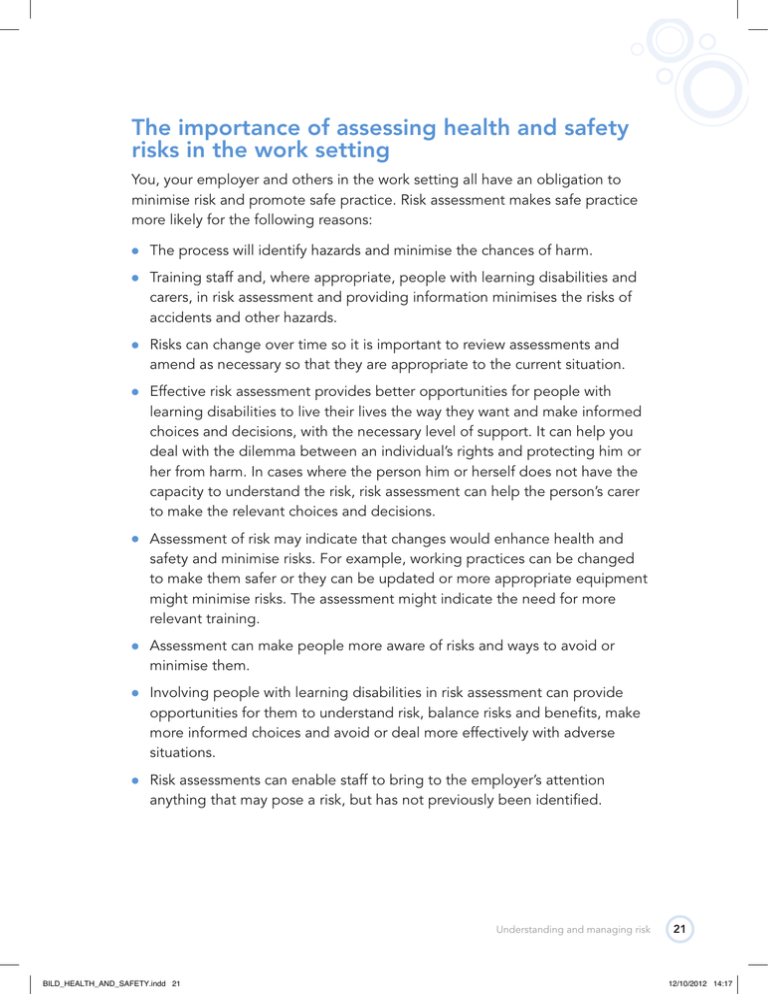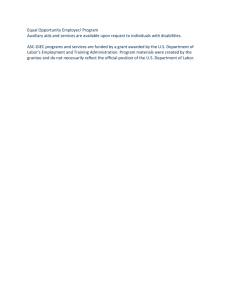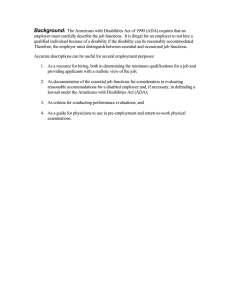The importance of assessing health and safety risks in the work setting
advertisement

The importance of assessing health and safety risks in the work setting You, your employer and others in the work setting all have an obligation to minimise risk and promote safe practice. Risk assessment makes safe practice more likely for the following reasons: MM MM MM MM MM MM MM MM The process will identify hazards and minimise the chances of harm. Training staff and, where appropriate, people with learning disabilities and carers, in risk assessment and providing information minimises the risks of accidents and other hazards. Risks can change over time so it is important to review assessments and amend as necessary so that they are appropriate to the current situation. Effective risk assessment provides better opportunities for people with learning disabilities to live their lives the way they want and make informed choices and decisions, with the necessary level of support. It can help you deal with the dilemma between an individual’s rights and protecting him or her from harm. In cases where the person him or herself does not have the capacity to understand the risk, risk assessment can help the person’s carer to make the relevant choices and decisions. Assessment of risk may indicate that changes would enhance health and safety and minimise risks. For example, working practices can be changed to make them safer or they can be updated or more appropriate equipment might minimise risks. The assessment might indicate the need for more relevant training. Assessment can make people more aware of risks and ways to avoid or minimise them. Involving people with learning disabilities in risk assessment can provide opportunities for them to understand risk, balance risks and benefits, make more informed choices and avoid or deal more effectively with adverse situations. Risk assessments can enable staff to bring to the employer’s attention anything that may pose a risk, but has not previously been identified. Understanding and managing risk BILD_HEALTH_AND_SAFETY.indd 21 21 12/10/2012 14:17 Thinking point Think about an activity you are involved in regularly in your work and about the environment where it occurs. How important is a risk assessment in this situation and why? Your employer’s legal responsibilities in relation to risk Under the Health and Safety at Work Act 1974 and Management of Health and Safety at Work Regulations 1999, risk assessment is a legal requirement in work settings which employ more than five people. If a risk assessment shows that the work cannot be done safely, other arrangements have to be put in place. Risk assessment takes account of risks to employees, the person/s being supported, and anyone else involved. The Health and Safety Executive in their document Five Steps to Risk Assessment describes a risk assessment as: ‘...simply a careful examination of what, in your work, could cause harm to people, so that you can weigh up whether you have taken enough precautions or should do more to prevent harm.’ There is no specific way of doing a risk assessment but the HSE suggests a five step approach: 1. Identify the hazards (remember, a hazard is anything that may cause harm). 2. Decide who might be harmed and how. 3. Evaluate the risks and decide on precautions. 4. Record your findings and implement them. 5. Review your assessment and update if necessary. Your responsibilities Under health and safety law you as an employee are required to: MM MM take reasonable care of your own and other people’s health and safety; MM co-operate with your employer on health and safety; MM 22 follow the training you have received when using any work items your employer has given you; tell someone (your employer, supervisor, or health and safety representative) if you think inadequate precautions are putting anyone’s health and safety at serious risk (www.hse.gov.uk). Health and safety for learning disability workers BILD_HEALTH_AND_SAFETY.indd 22 12/10/2012 14:17 Risk assessment in an organisation Here are some of the risk assessments commonly undertaken by health and social care organisations: MM Food safety and hygiene MM Moving and positioning/handling of people and objects MM Infection control MM Personal safety and lone working MM Fire safety MM How to deal with an emergency MM Smoking at work MM Use of hazardous (harmful) materials MM Waste management and disposal MM Security measures and visitors in the work setting Risk assessment in someone’s home Risk assessment and control is also required when the work setting is someone’s own home, but the approach is obviously less formal and written records are unlikely unless there are special circumstances (of offending behaviour, risk to life, etc.). In this instance the risk assessments will be an integral part of the support plan. Your employer, whether this is the person you support or a carer, or a support provider, must make sure that all measures are in place to minimise risks and provide you with any equipment necessary for you to do your job as required. How and when to report potential health and safety risks The degree of risk varies with the nature of an activity or event and the situation in which it occurs. For example: Ruth and Ellen use a hoist when helping Martha with personal care. One day Martha slips through the sling and lands on the floor, though fortunately she slips out slowly and doesn’t hurt herself. Should Ellen and Ruth report this? Understanding and managing risk BILD_HEALTH_AND_SAFETY.indd 23 23 12/10/2012 14:17 It’s pretty obvious, isn’t it? Of course they should. Martha has been losing weight and becoming frailer so the sling that was once suitable could now put her in danger. Or perhaps they just didn’t fasten it properly. Whatever the cause, it’s an incident that needs to be reported. The risk needs to be reassessed in relation to Martha’s needs, by a moving and positioning specialist, and then control measures put into place. You should report and/or seek advice on all situations which you consider present risks, verbally to your line manager or a designated health and safety representative and in writing according to the procedures of your organisation. If you identify health and safety risks in someone’s home setting, these should be reported to your organisation or you should seek advice from a health and safety specialist if employed directly by the person you support, or a carer. When to report risks you have identified MM MM MM MM MM MM MM When there is the danger of significant physical, sexual or psychological harm to someone you should report this immediately. When someone is putting him or herself at risk and does not seem to have the capacity to judge the harm that might result, you need to report this. For example when someone is staying out all night without telling people where she is going or someone is being coerced by friends to do something against his will. If an event occurs outside the work premises, report the risk as soon as you return. When safety control measures are inadequate or when additional measures are required, e.g. poor lighting is causing falls. When changes to work practices put people at risk, for example when new shift patterns mean residents are being left alone for long periods. When someone’s abilities change and he or she can no longer manage something previously within their capability. When you suspect that someone might be ill, but they are unable to tell you – this is particularly relevant to people with profound and multiple learning disabilities. You also have a responsibility to support other people in following safe practice. This includes your colleagues and the person/s you support, as well as any volunteers you work with. It can be tempting when time is short to 24 Health and safety for learning disability workers BILD_HEALTH_AND_SAFETY.indd 24 12/10/2012 14:17 ignore guidelines for safe practice, but to do so could cause harm to yourself and others, contravene your employer’s procedures and even break the law. Reporting risks that occur in someone’s own home In the same way as described above, you should make your employer aware of any risks which have not been included in the risk assessment. While you have a right to work in a safe environment, you must also recognise that you cannot expect some things to be changed in someone’s own home, except in serious or dangerous situations. Activity Think about your own work setting and a person you support. List three risks you are aware of in relation to supporting that person. These should preferably be risks you have identified yourself. If this is not possible, use ones which are part of existing risk assessments. Next write beside each risk what you can do to minimise that risk. Finally, state how and to whom you would report this risk if it has not been identified in risk assessments or who you would discuss it with for further information. What questions would you ask? Involving people with a learning disability in risk assessment, choice and decision making There is an increasing emphasis on the rights of people with learning disabilities to be involved in the assessment and management of their own risks and to take responsibility in doing so. This is supported and encouraged by the self advocacy movement and leading activists with learning disabilities. Obviously, the extent to which people do this relies on their capacity. Where the person him or herself is not able to manage their own risks, the responsibility can be taken by the prime carer. Helen Sanderson and her colleagues argue that traditional methods of risk assessment are not appropriate for most people with a learning disability, and they advocate person centred approaches to risk assessment: Traditional methods of risk assessment are full of charts and scoring systems, but the person, their objectives, dreams and life seem to get lost somewhere Understanding and managing risk BILD_HEALTH_AND_SAFETY.indd 25 25 12/10/2012 14:55

